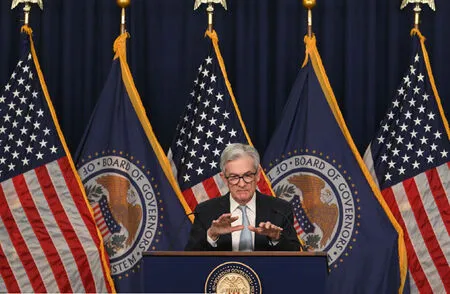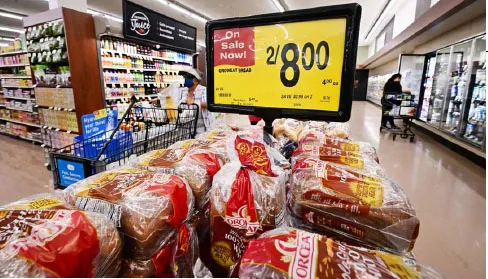U.S.Faces Worst Inflation in Four Decades
By Li Shimeng
The global economic recovery is seriously challenged
The U.S.is fighting inflation unseen since the 1980s.Statistics showed that its core consumer price index(CPI),excluding food and energy,measured a 6.6 percent increase in September from a year earlier,reaching a level not seen since the 1982 oil shock.
The high inflation figures affected the U.S.midterm elections in November.A poll released in October by the Center for American Political Studies at Harvard University found that 58 percent of respondents were not confident in the Biden administration’s ability to bring down inflation.
Runaway Inflation
“In the economic sector,when it comes to inflation,the central issue,alongside rising prices,is inflation expectations,” said Ma Wei,an assistant research fellow at the Institute of American Studies of the Chinese Academy of Social Sciences,to China Report ASEAN.“When people believe that prices will continue to rise in the future,they buy more.Meanwhile,businesses reduce supply or shift costs to customers.Such an imbalance between supply and demand fuels an increase in commodity prices and eventually leads to real inflation,which is now unfolding in major developed countries including the U.S.This is also a situation that concerns policymakers in these countries most.”

On November 2,2022,U.S.Federal Reserve Chair Jerome Powell announces at a press conference an interest rate hike by 75 basis points to a range between 3.75 and 4 percent. (CHEN MENGTONG)
The U.S.government has been pursuing the goal of containing the Personal Consumption Expenditure(PCE) deflator,a measure of inflation based on changes in personal consumption,to 2 percent.“A PCE deflator at 5 to 6 percent or even higher usually indicates inflation is spinning out of control,” explained Ma.The PCE deflator in the U.S.started rising in the second quarter of 2021 and stayed at 5-plus percent from the beginning of this year.“High inflation has plagued the U.S.economy.”
The core inflation rate,which excludes items frequently subject to volatile prices like food and energy,is considered a more accurate gauge of changes in the prices of goods and services.“The ongoing inflation in the U.S.was primarily fueled by rising prices of services,” Ma said.“An analysis of figures in recent months showed that food and energy prices roughly stayed stable while prices of core inflation items such as airlines,accommodations,and catering services went up.”
“To survive current difficulties,we have no choice but to raise prices,”sighed a restaurant owner in Connecticut.“The purchase price of seafood is three times higher than before the COVID-19 pandemic,and we charge only 15 percent more,which means a much narrower margin.”
Raising Interest Rates
This March,the Federal Reserve,the U.S.central bank,took emergency action to curb domestic capital flow and surging inflation.The benchmark interest rate was raised by 25 and 50 basis points(a basis point equivalent to 0.01 percent) in March and May,respectively.
Multiple experts interviewed by China Report ASEAN agreed it was too late.“If the Fed had implemented such monetary policy a quarter earlier,the situation might not have become so tough,” said Chen Dafei,chief economist at the Wealth Management Business Department of Orient Securities.
After the CPI peaked at 9.1 percent in June,the Fed further raised interest rates by 75 basis points in June,July,and September,the biggest rate hike since 1994.The Fed’s benchmark rate is currently running somewhere between 3 and 3.25 percent.
Fed Chair Jerome Powell said at a June press conference that to keep inflation down,the Fed would still opt to raise rates depending on future economic data,and that they expected a rate in a range between 3 and 3.5 percent by the end of 2022.

A white-collar walks past an advertisement for a job website in Arlington,Virginia,U.S.A.,on June 3,2022.(XINHUA)
Several other Fed officials have recently implied that there would be at least one more 75 basis-point rate hike in 2022 as inflation figures far exceeded expectations.Experts told China Report ASEAN that the Fed might not stop before the interest rate is raised to 4.5 to 5 percent or even higher.
“The Fed’s rate hikes could exert a great impact on the world economy,”opined Ma Wei.The Fed plays the role of the world’s central bank,so when it raises rates,capital flow in interest-rate sensitive sectors and most countries in the world will slow down,noted Chen Dafei.
On August 16,U.S.President Joe Biden signed the Inflation Reduction Act of 2022 into law to fight inflation by cutting the deficit and increasing taxes on large corporations.Since the legislation is not directly related to inflation control,its role in boosting the U.S.economy is considered limited and may intensify global competition in the clean energy sector.
In fact,the Fed’s rate hikes have already caused exchange rate shocks in many countries.In September,the Japanese yen weakened past 150 against the U.S.dollar,hitting a 32-year low,and the British pound plunged by 20 percent against the U.S.dollar.

Inside a supermarket in Montebello,Virginia,U.S.A.,August 23,2022.(XINHUA)
“The future scenario is likely to be grimmer for developing countries and emerging economies than it has been for developed countries,” said Ma Wei.“Affected by the U.S.rate hikes,a sliding currency in these countries would lead to an increase in capital outflow.Meanwhile,for countries struggling with heavy debt like Sri Lanka,the depreciation of their currencies would put them under greater pressure with their foreign reserves already running short.”
Three Rounds of Inflation
The persistent increase in consumer prices in the U.S.has been caused by three major factors successively.
The U.S.already started to feel inflation pressures in April of last year when its core PCE jumped to 3.1 percent from 1.8 percent in March.The U.S.government alleged that the inflation was only temporary and could soon be brought under control.It eventually turned out that the Fed had to cope with a situation more complex than the 1980s oil glut,which was fueled mainly by geopolitical conflicts,and that the contributing factors to the rampant inflation in the U.S.have been constantly changing.
The persistent increase in consumer prices in the U.S.has been caused by three major factors successively,according to Ma Wei.First,it was supply chain disruptions.With unprecedented uncertainty presented by the COVID-19 pandemic,travel restrictions had yet to be lifted in the U.S.at the beginning of 2021,and transportation service was effectively suspended both at home and abroad.The disrupted supply chain led to higher commodity prices.“For a while,many American truck drivers were quitting for fear of the virus,” Ma noted.
Due to the outbreak of the Russia-Ukraine conflict in early 2022,soaring food and energy prices triggered the second round of inflation in the U.S.But unlike European Union countries,the U.S.is self-sufficient in energy and also a food exporter.So after Biden announced the release of national oil reserves in June,prices of food and energy came down to some extent,Ma said.
Since June,the core CPI,from which food and energy prices are exempt,has been climbing higher,and the increasing costs of services became the principal cause of the ongoing inflation in the U.S.
“At this stage,the price increase in services resulted from an overheated labor market,” noted Ma.The U.S.Labor Department statistics showed that the country’s employers added 263,000 new jobs in September while the unemployment rate fell to 3.5 percent,matching its lowest level since the 1960s.

A digital sign at a petrol station in Los Angeles,California,U.S.A.,displays gasoline prices on October 3,2022,when the city’s average price hit a record high. (ZENG HUI)
According to Chen Dafei,America is now facing a labor shortage.The Trump administration’s policy of reducing illegal immigration coupled with some 2 to 4 million-strong labor force having been made incapable of work during the COVID-19 pandemic has led to an insufficient supply of workers.
“The U.S.labor market currently has a demand-supply gap of 3 million workers,and the gap is not likely to be bridged until at least next year,”opined Chen Dafei.Ma Wei agrees with Chen and believes that it is a tough challenge to get the ongoing inflation in the U.S.caused by the increase in service prices under control.Unlike commodity prices,the costs of service prices,such as rent and wages,are often adjusted on a monthly,quarterly,or annual basis,which means the prices of service are rather difficult to cool down quickly.
Soft Landing Seems Hard
Under mounting inflation pressures,a global recession seems just around the corner.
Ma Wei pointed out that the only way out for the U.S.is rate hikes.“The Fed has to demonstrate its determination to fight inflation to boost the confidence of both employers and employees as well as personal consumption,” he said.
Chen Dafei predicted the U.S.would see an inflation turning point in the fourth quarter of this year or the first quarter of next year if interest rates continue to rise,while Ma Wei suggested it could take longer,to the middle of 2023.
However,side effects of interest rate hikes have emerged with the stock market sliding.“What we have observed is the financial market’s reaction to a 4 percent interest rate,”Chen Dafei noted.“The market value of many listed companies has fallen but they still earn profits.If the Fed does raise interest rates to 4.75 percent as forecast,the stock market will continue to slump.”
A cooling economy is likely to increase unemployment.“If the U.S.economy slows down,businesses may have to downsize their workforce,” said Ma Wei.“It is estimated that a 5 percent unemployment rate and a lack of confidence in consumption and investment would lead to a substantial recession.”
According to a World Bank report released in September,more than two-thirds of countries in the world have tightened monetary and fiscal policies.The report suggested a global downturn and economic crises in emerging markets and developing countries in 2023 as central banks opt for rate hikes one after another.
Could the world economy possibly realize a soft landing? Chen Dafei noted that next year’s global economic growth rate,if not negative,will likely be very low.Ma Wei shared Chen’s view and pointed out that it is rather difficult for the Fed to curb inflation with the prospect of mild economic growth.
Chen Dafei added that all world economies are going to see a slowdown and slide into recession in 2023.The U.S.and European countries have already begun this process in 2022.Emerging economies would enter the early stages of economic downturn to recession next year,though economic figures in countries like India and Vietnam now look good because they are among the latest to achieve economic recovery.
With increasing inflation pressures around the world,China’s economy grew less than expected in the second quarter of this year.But China sees no need to raise rates,according to Ma Wei.“Bandwagon is not our style,” he explained.“Depreciation of the RMB is generally under control,and due to underconsumption,we actually have deflationary pressures.” China has a complete manufacturing industrial chain with good production capacity and at present,inadequate consumer demand remains the core of the economic slowdown,added Chen Dafei.

